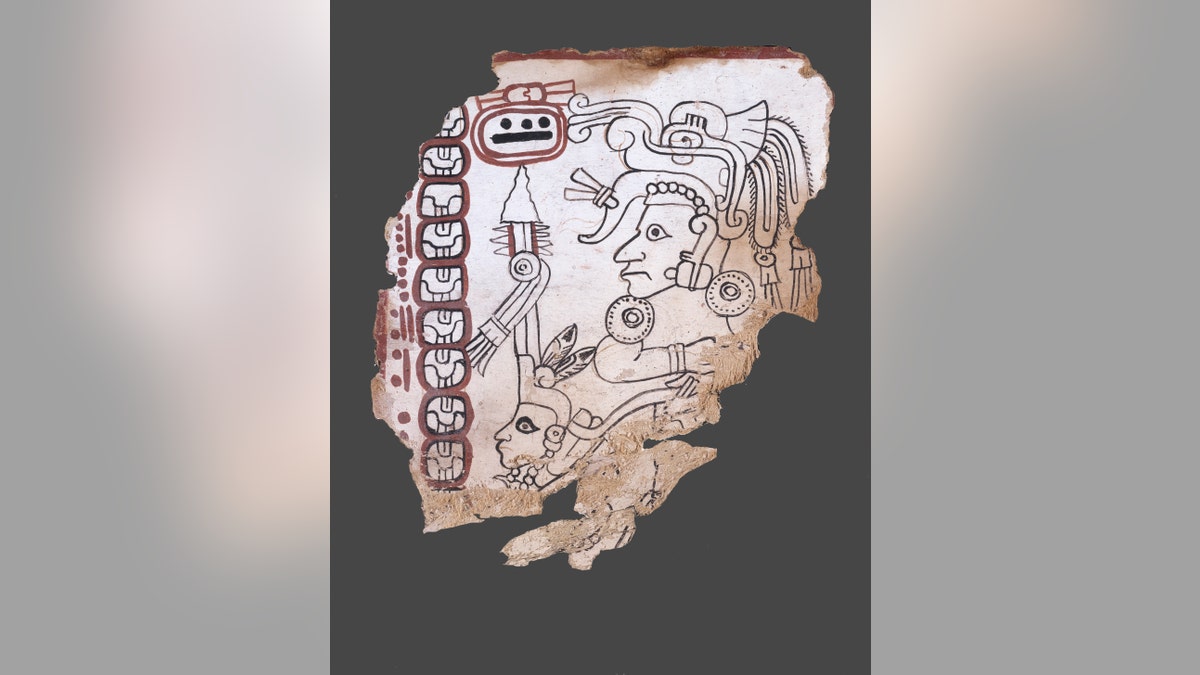
Page from the Grolier Codex. (Enrico Ferorelli)
An ancient Mayan document long thought to be a forgery was recently found to be genuine. The text, known as the Grolier Codex, was analyzed by researchers from Yale, Brown, and the University of California, Riverside, and, according to their results, is the real thing.
The codex—a ten page document consisting of Mayan deity/ritual paintings and a calendar that charts the movement of Venus—dates back to the first half of the 13th century, making it the oldest surviving document from the Americas.
Consisting of amate paper made from fig tree bark, the codex was widely believed to be a forgery partially due to the circumstances in which it turned up back in the late 60’s. The story goes that collector Josue Saenz was flown to a remote airstrip somewhere in the Mexican state of Chiapa, where a crew of looters met him. They showed him the ancient Mayan text, claiming to have found it in a dry cave along with several other artifacts including a wooden mask and sacrificial knife (all which later proved genuine).
In 1971, Saenz allowed archaeologist (and one of the new study’s authors) Dr. Michael Coe to display it in New York City’s Grolier Club. Thereafter, the newly-dubbed Grolier Codex was taken to the basement of the Mexican National Museum of Anthropology in Mexico City, where it sits to this day.
After the unveiling, there were a lot of dismissals of the codex as a forgery, which eventually became a dogma that followed the artifact for decades. Dr. Stephen Houston, a professor at Brown University and one of the researchers who analyzed the text, chalked these up partly to the document’s origins.
“By definition, an object without clear provenance or place of origin opens room for doubt,” Houston told FoxNews.com. “But there are many other criteria too, and many of these doubts were themselves doubtful.”
Related:
The codex was first unveiled at a time when ancient Mayan documents were being faked, so people had reason to be wary. However, Houston said that forged codices are relatively obvious.
“There are a number of faked Maya codices from the 1960s and before,” he explained. “All are obvious, copying from preexisting codices, daubed with garish color.”
Dr. Michael Coe, study co–author and Yale professor, agreed.
“In my career (I'm 87), I've seen over 50 fakes, and they're all sorry, totally naive productions by fakers who know nothing of Maya writing or astronomy,” Coe told FoxNews.com. “So when I published [a copy of] this manuscript back in 1973, quite a few Mayanists automatically condemned it as a fake.”
In Coe’s opinion, the forgery accusations by “so-called experts” involved a lot of academic and international politics.
“All of them have failed to realize that the Grolier Codex is a kind of hybrid, made by a priestly scribe living on the frontier between the Maya and other non-Maya peoples in Mexico, [which] shows that when it was painted, it combined Maya and non-Maya ways of writing numbers, etc.,” he said.
In two previous studies reviewed by Coe and Houston’s team, the codex had been radiocarbon-dated to prove that the amate paper used was indeed from the first half of the 13th century. The team then spent two and a half years studying highly detailed photographs—full-size Ektachromes of all ten pages, front and back—taken of the codex in 1988 while it was still out of sight in a Mexico City storeroom.
The study that emerged should put all objections over the document’s authenticity to rest. For one, the Grolier Codex depicts deities that had yet to be discovered in the 60’s, which would make it almost impossible for someone at the time to forge.
“There are details of the gods shown and the system of writing numbers that have only been revealed to archaeologists long after the time that the Grolier Codex first came to light in a Mexican private collection,” Coe explained. “If this was a fake, the faker would have to have been able to look into the future.”
Also, technology that could accurately duplicate the blue pigment used in the codex’s artwork wouldn’t be perfected until the 80’s. These are just a few examples of how it would be virtually impossible for con artists in the 60’s to forge the document, examples detailed in an article published in the latest issue of Maya Archaeology.
Now that the Grolier Codex has been authenticated, Houston believes it should be removed from the National Museum’s basement and given the reverence it deserves. Coe shares the sentiment.
“I do hope that the Mexican authorities will realize that they have a national treasure, namely the oldest written book in the New World,” he said.




















